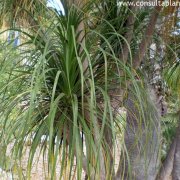Care of the tree Beaucarnea beldingii or Elephant's-foot |
|
The genus Beaucarnea, family Asparagaceae, includes about 15 species of tropical trees native to Mexico and Central America. Some species are: Beaucarnea beldingii, Beaucarnea hiriartiae, Beaucarnea gracilis, Beaucarnea goldmanii, Beaucarnea recurvata, Beaucarnea guatemalensis. Common name: Elephant's-foot. Scientific synonym: Nolina beldingii. This species is native to Baja California, México. They are low-branched, slow-growing tropical trees that reach 6 meters (19,68 feet) in height. The long, thin (up to 1 meter/3.28 feet in length) bluish-green leaves appear in rosettes and have serrated margins. The small cream-colored flowers appear in long branching inflorescences up to 2 meters (6.56 feet) in length. They bloom in summer. The fruits are woody capsules 1 cm (0.39") in diameter. Elephant's-foot is used in rockeries, on dry slopes, as isolated specimens, in cactus and succulent gardens and in pots that are wider than deep when they are young. It's are ideal for Mediterranean coastal gardens. Beaucarnea beldingii grows in full sun and light shade exposures. It resists frost down to -10 ºC (14 ºF). The soil can be a mixture, in the same proportions, of normal garden soil and coarse sand. It is important that the drainage is excellent. Water moderately waiting for the substrate to dry completely; in winter they keep up with the rains. It's very resistant to drought plants. Nolina beldingii does not need fertilizers or pruning. Beaucarnea beldingii is a plant sensitive to excess watering that rot the roots. Elephant's-foot is propagated from seeds sown in spring in the seedbed but it is a very slow process. |
Images of the tree Beaucarnea beldingii or Elephant's-foot |
Find plants
Beaucarnea beldingii or Elephant's-foot | Care and Growing
© 2025 FavThemes



